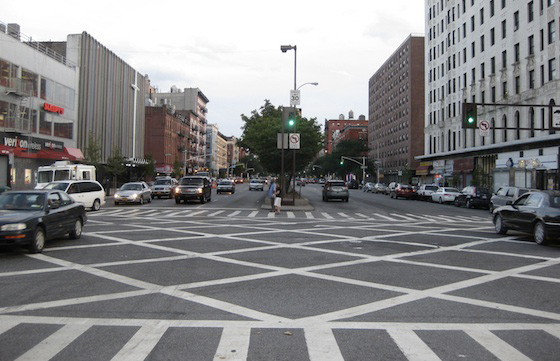
After more than three years of delay and debate, safety improvements may finally be coming to one of Harlem's deadliest avenues. Under a plan tentatively okayed by Manhattan Community Board 10's transportation committee last night [PDF], Adam Clayton Powell, Jr. Boulevard will get wider medians, shorter crossing distances, and narrower traffic lanes in an attempt to improve safety for all users of the street.
The need to redesign Adam Clayton Powell is pressing. Since 2006, ten people have been killed in traffic crashes on the boulevard, according to DOT, compared to two on nearby Frederick Douglass Avenue and three on Lenox Avenue. The victims, all pedestrians, were mostly senior citizens close to home. Their average age was 62, and nine of ten lived within a block of Adam Clayton Powell. "Seniors are tough and resilient," said DOT Planning and Operations Coordinator Naomi Iwasaki, "but we all know they're our most vulnerable street users."
The problem is rampant speeding. During the morning rush hour, the average speed on the street is 36.8 miles per hour heading southbound and 39 miles per hour northbound, according to DOT Bike Program Coordinator Hayes Lord. After 8:00 p.m., when traffic is lighter, average speeds spike to 52 and 49 miles per hour: highway speeds on a neighborhood street, far exceeding New York City's 30 mph limit. The speeds reflect the interstate-like design of the street -- three 12-foot wide moving lanes in each direction.
In response, DOT proposed converting the left-most lane in each direction, where most of the deadly crashes took place, to left turn lanes. At intersections, this would free up space for pedestrian medians to be widened with paint and planters or flexible posts, reducing crossing distances. And by moving through traffic out of the left lane, the change is expected to reduce dangerous weaving and help prevent the most common kind of crash on the boulevard, rear-end collisions.
Where drivers can't make left turns because of one-way cross-streets, pedestrian space can be extended on both sides of the median using the same materials. This would further shorten crossing distances at those intersections, a particular boon for the large number of seniors and children who live in the neighborhood.
At all intersections, the paint-and-planters treatment would be used to extend the median into the intersection, providing more protection for pedestrians in the crosswalk. Traffic lanes would be narrowed to 10 feet for left-turning traffic and 11 feet for through traffic.
The plan is not DOT's most ambitious street redesign, particularly given the extremely dangerous conditions on the street today, but it adds significant space for pedestrians. Previous efforts to change Adam Clayton Powell have fallen short at the community board. In 2009, the full board of CB 10 overturned its transportation committee and voted against a proposal to replace traffic lanes with buffered bike lanes.
At a workshop held last September, many participants argued for preserving the speedway conditions on Adam Clayton Powell. "As a driver, I like that," said board chair Henrietta Lyle at the time.
This plan, too, drew skepticism from many board members. "On Sunday mornings, if we have double parked cars, that'll mean we'll have just really one good lane going down," worried Lyle, who also praised the plan on safety grounds. "You're taking a boulevard and turning it to one functional lane," echoed board member Barbara Nelson. "We have a bad asthma rate because of the congestion." Among members of the public who attended, more than one said that most pedestrian fatalities were probably the fault of jaywalkers.
But support for the plan was strong, particularly among Harlem's leading community organizations. "Our seniors were highly concerned about the issues on Adam Clayton Powell Boulevard," said William Hamer, director of senior services with the Abyssinian Development Corporation. "It's important for us to take a proactive position."
"I think the improvements are great for Seventh Avenue," said Jael Sanchez of the Harlem Children's Zone. "I struggle to cross the streets. There's not enough time for me as a 32-year-old to get across."
The committee ultimately decided to draft a resolution incorporating support for the overall concept and some of the criticisms raised at the meeting -- in particular, worries that planters couldn't be maintained properly -- and bring it to the full board in June.






